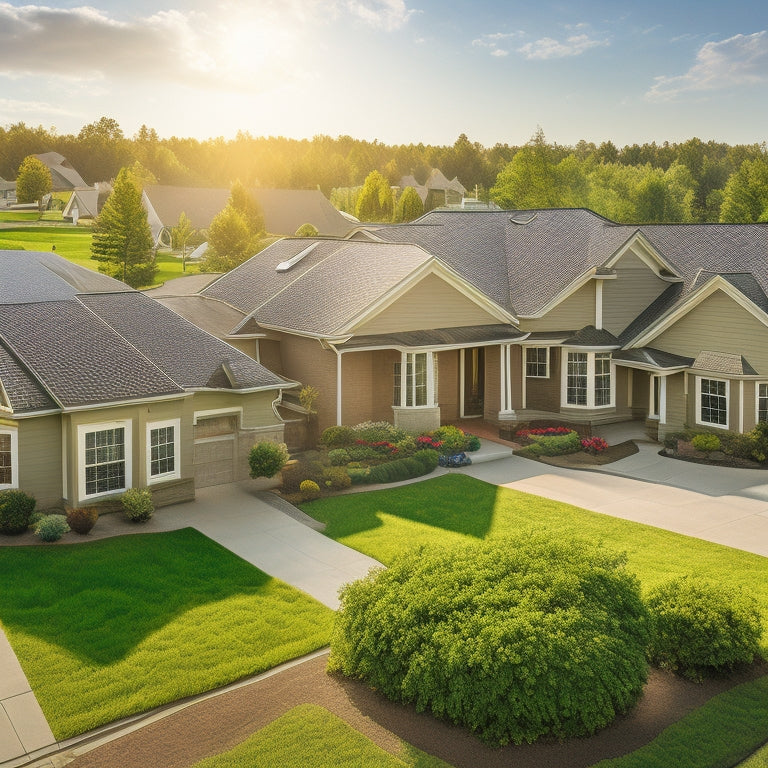
What to Consider When Installing Roof-Mounted Panels
Share
When installing roof-mounted solar panels, you'll need to take into account more than just the panels themselves. Evaluate your roof's condition, making sure it can support the weight of the panels, and choose a compatible mounting system. Determine the best panel angle for maximum energy production, and guarantee structural integrity by verifying local building codes and regulations. You'll also need to select suitable panel material, plan for energy storage, manage roof ventilation, and schedule regular maintenance. As you prepare for your installation, remember that a thorough understanding of these factors is key to a successful and efficient solar panel system - and there's more to explore.
Key Takeaways
• Assess the roof's condition, age, and historical significance to ensure it can support the weight of the solar panels and mounting system.
• Choose a mounting system compatible with the roof material and structure, considering weight, size, and cost.
• Determine the optimal panel angle for maximum energy production, based on latitude, climate, and local conditions.
• Ensure the installation complies with local building codes and regulations, obtaining necessary permits to avoid legal issues.
• Plan for energy storage and ventilation, calculating battery capacity and ensuring airflow to prevent heat buildup and moisture accumulation.
Assessing Your Roof's Condition
Before installing roof-mounted panels, you need to examine your roof's condition to make sure it can support the additional weight and withstand environmental stresses. A thorough evaluation is important to guarantee a safe and efficient installation. Start by evaluating your roof's age, as older roofs may require additional reinforcement or replacement before installing panels.
Historical significance is also a key consideration, as historic homes or buildings may have unique requirements or restrictions that must be addressed.
Inspect your roof for signs of wear and tear, such as damaged or missing shingles, curled or buckled roofing, and signs of animal or insect infestation. Check for sagging or uneven rooflines, which can indicate structural issues. You should also verify that your roof's framing and decking can support the weight of the panels, as well as the additional weight of snow, if applicable.
Choosing the Right Mounting System
With your roof's condition assessed, you can now focus on selecting a mounting system that will securely fasten your roof-mounted panels. This is an important step, as a faulty mounting system can lead to compromised panel performance and even roof damage.
When choosing a mounting system, consider the type of roof you have, as well as the weight and size of your panels. You'll want to make sure the system is compatible with your roof's material and structure.
Cost considerations are also vital, as different mounting systems vary greatly in price. Be sure to factor in the cost of the system, as well as any additional components you may need, such as flashing or clamps.
Additionally, look for manufacturers that offer extensive warranty options, which can provide peace of mind and protect your investment. A reputable manufacturer should offer a warranty that covers the mounting system for at least 10 years.
Determining Optimal Panel Angle
When determining the best panel angle for your roof-mounted solar panels, you'll need to take into account two key factors:
your location's latitude and climate, and the ideal tilt and orientation for maximum energy harvest.
In general, panels should be tilted between 30 and 40 degrees to guarantee top energy production, but this angle may vary depending on your region.
Latitude and Climate Effect
Your location's latitude and climate have a substantial impact on the best angle for your roof-mounted solar panels, as it directly affects the amount of energy they can harness from the sun. At lower latitudes, near the equator, the sun's rays strike the Earth at a more direct angle, resulting in higher solar irradiance. This means you can get away with a shallower panel angle to maximize energy production.
Conversely, at higher latitudes, the sun's rays hit the Earth at a more oblique angle, requiring a steeper panel angle to capture the most energy.
Climate also plays a significant role in determining the ideal panel angle. In regions with frequent overcast weather, a steeper angle may be necessary to minimize debris accumulation and ensure water runs off the panels. In areas with intense weather patterns, such as hurricanes or heavy snowfall, a more secure mounting system may be required to withstand extreme weather conditions.
Understanding your local climate and latitude will help you determine the most suitable panel angle, ensuring you get the most out of your roof-mounted solar panels. By considering these factors, you can optimize your system's performance and maximize your energy harvest.
Ideal Tilt and Orientation
To determine the best panel angle for your roof-mounted solar panels, you'll need to take into account the ideal tilt and orientation, which can vary depending on the location and purpose of the installation. The ideal angle guarantees maximum energy production, taking into consideration the local climate and shading conditions.
Here are some key factors to take into consideration when determining the ideal tilt and orientation:
-
Latitude and seasonal variations: Adjust the tilt to accommodate seasonal changes in the sun's angle.
-
Roof pitch and layout: Ensure the panels are installed at an angle that complements the roof's design and doesn't compromise its aesthetic appeal.
-
Shading analysis: Assess potential shading from nearby objects, such as trees or buildings, to optimize panel placement.
- Local building codes and regulations: Verify compliance with local regulations and building codes regarding panel installation and orientation.
Ensuring Structural Integrity
Before you begin installing roof-mounted panels, you'll need to confirm that your roof can handle the added weight and stress.
To do this, you'll need to conduct a thorough roof capacity analysis, taking into account factors such as load calculation and structural reinforcement needs.
Roof Capacity Analysis
Before installing roof-mounted solar panels, you must verify whether your roof can support the added weight of the panels and racking system to guarantee the structural integrity of your building. This is vital to prevent any damage to your roof or the panels themselves. A thorough roof capacity analysis is essential to make sure a safe and efficient installation.
When conducting a roof capacity analysis, consider the following factors:
-
Roof age: Older roofs may be more susceptible to damage or collapse under the added weight of the panels.
-
Building history: Check if the building has undergone any significant renovations or repairs that could affect its structural integrity.
-
Roof material and condition: The type and condition of your roof can greatly impact its ability to support the added weight.
- Local building codes and regulations: Be certain that your installation complies with local building codes and regulations.
Load Calculation Factors
When calculating the load capacity of your roof, you'll need to take into account several factors to guarantee the structural integrity of your building. You must consider the weight of the solar panels, the mounting system, and any additional components. Peak loads, such as those caused by wind, snow, or rain, must also be factored in to make sure your roof can withstand extreme weather conditions.
Energy efficiency is essential, but it's equally important to confirm that your roof can support the added weight of the solar panels. A thorough load calculation will help you determine the maximum weight your roof can handle, preventing potential damage or collapse.
You should also consider the roof's material, age, and condition, as these factors can affect its load-bearing capacity.
Structural Reinforcement Needs
You must assess whether your roof requires structural reinforcement to guarantee it can support the added weight of the solar panels and withstand environmental stresses. This is vital to ascertain the structural integrity of your roof and prevent potential collapses or damage.
To determine if reinforcement is necessary, consider the following factors:
-
Roof age and condition: Older roofs may require additional support to handle the weight of solar panels.
-
Panel weight and size: Larger or heavier panels may necessitate reinforcement to prevent roof collapse.
-
Local building codes: Check with local authorities to ensure compliance with building codes and regulations.
- Foundation inspection: Verify that your roof's foundation can support the added weight and stress of the solar panels.
In some cases, beam design modifications or foundation inspections may be necessary to guarantee the structural integrity of your roof.
Don't compromise on safety – confirm that your roof can support the weight of your solar panels and withstand environmental stresses.
Considering Local Building Codes
Local building codes and ordinances dictate specific requirements for roof-mounted solar panels, and it's important to familiarize yourself with these regulations prior to installation. You'll need to research and comply with local zoning regulations, which may restrict the size, location, and appearance of your solar panel system.
For instance, some areas may have specific requirements for setbacks, roof coverage, or aesthetic considerations.
Additionally, you'll need to obtain the necessary permits before installing your roof-mounted solar panels. Permit requirements vary by jurisdiction, but typically include electrical, building, and zoning permits. You may also need to provide documentation, such as system designs, electrical plans, and certification from a licensed electrician.
Failure to obtain the necessary permits can result in fines, removal of the system, or even legal action. By understanding and complying with local building codes and ordinances, you can ensure a smooth installation process and avoid costly delays or penalties.
Selecting Suitable Panel Material
As you explore the options for your roof-mounted solar panel system, selecting the appropriate panel material is essential, since it directly affects the system's efficiency, durability, and overall cost.
The right material can enhance your system's energy efficiency, reduce maintenance needs, and even boost your home's aesthetic appeal.
When choosing a material, consider the following key factors:
-
Durability: Will the material withstand harsh weather conditions and last for decades?
-
Efficiency: How well does the material convert sunlight into usable energy?
-
Cost: What's the upfront cost of the material, and will it provide a good return on investment?
- Weight and structural integrity: Can your roof support the weight of the panels, and will they compromise your roof's structural integrity?
Planning for Energy Storage
Planning for energy storage is crucial to guarantee that your roof-mounted solar panel system can provide a reliable and efficient source of power when the sun isn't shining.
As you consider your energy storage needs, you'll want to think about battery sizing. This involves calculating the right battery capacity to meet your energy demands during periods of low sunlight or at night. A properly sized battery will secure that you have a steady supply of power when you need it most.
When it comes to grid connection, you'll need to decide whether you want a grid-tied system or an off-grid system. A grid-tied system allows you to sell excess energy back to the grid and draw from it when needed, while an off-grid system relies solely on your solar panels and energy storage.
Consider your energy usage patterns and local regulations when making this decision. By carefully planning for energy storage, you can enjoy a reliable and efficient source of power that meets your unique needs.
Managing Roof Ventilation
You'll need to make sure your roof is properly ventilated to prevent heat buildup and moisture accumulation, which can compromise your solar panels' performance and lifespan. Proper ventilation guarantees air circulation under the panels, reducing the risk of heat buildup and moisture accumulation. This is important, as high temperatures can decrease your panels' efficiency, while moisture can lead to corrosion and damage.
To guarantee adequate ventilation, consider the following:
-
Soffit vents: Install soffit vents in your roof's overhang to allow air to circulate from the underside of the roof.
-
Ridge vents: Install ridge vents along the peak of your roof to allow hot air to escape.
-
Intake vents: Install intake vents in your roof's soffit to draw in cool air.
- Exhaust vents: Install exhaust vents near the ridge of your roof to release hot air.
Scheduling Regular Maintenance
Regular maintenance is essential to guarantee your roof-mounted solar panels continue to operate at peak efficiency, and scheduling routine checks can help identify potential issues before they impact your energy output.
You'll want to create a maintenance schedule that ensures your system is running smoothly and efficiently. This includes regular inspections to check for loose connections, damaged panels, and dirt buildup. You should also establish a cleaning routine to remove debris and dirt that can reduce your system's energy output.
A good rule of thumb is to clean your panels every 6-12 months, depending on your location and climate. Additionally, you should inspect your system's inverters and monitoring systems regularly to ensure they're functioning correctly.
Frequently Asked Questions
Can I Install Roof-Mounted Panels on a Metal Roof?
You can install roof-mounted panels on a metal roof, but make sure the metal roofing material is compatible and structurally sound, and consider the added weight, corrosion risks, and potential for leaking at panel mounts.
Do Roof-Mounted Panels Affect My Home's Resale Value?
As you weigh the pros and cons, consider this: roof-mounted panels can boost your home's appraisal impact, but only if they align with neighborhood trends, and you'll likely see a significant increase in resale value.
Can I Install Roof-Mounted Panels Myself or Diy?
You can attempt a DIY roof-mounted panel installation, but be aware that you'll need to navigate local codes, invest in proper safety gear, and possess advanced roofing and electrical knowledge to avoid costly mistakes.
Will Roof-Mounted Panels Be Damaged by Hail or Extreme Weather?
"You'll be relieved to know that modern roof-mounted panels are designed with weather resistance and storm durability in mind, so they can withstand hail and extreme weather conditions, ensuring your power supply remains uninterrupted."
Can I Add Roof-Mounted Panels to an Existing Solar Panel System?
You can add roof-mounted panels to an existing system, but guarantee system integration by checking panel compatibility, energy output, and existing infrastructure to avoid compatibility issues and optimize power generation.
Related Posts
-

What Makes Eco-Friendly Car Batteries a Smart Choice?
You're considering eco-friendly car batteries, and for good reason. They offer a trifecta of benefits that make them ...
-

Why RV Owners Need Solar Panels for Battery Life
You can greatly extend the life of your RV's batteries by switching to solar power. By harnessing the sun's energy, y...
-

What Does EV Charging Station Installation Cost?
You can anticipate paying between $300 to $1,500 or more for an EV charging station installation, depending on the ty...


